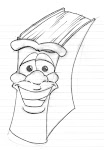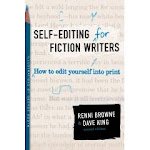Thank you for submitting Chapter Two. I hope you and others find the edit below helpful.
Strengths: You have a great voice, and Harry's got spunk. I like that kid. He brings in just the right amount of conflict, and that's what every story needs: conflict. Harry is also likable. You can see him trying, but you can also understand why he falls short. It's something all kids will connect with emotionally, and that's awesome. Harry's also got some heroic aspects about him because he fights back. That's also something kids will like because more often than not, kids are too afraid to fight back. Great job!
Weaknesses: You've got excellent conflict and Harry's personality is great, but right now, there's too much telling and not enough showing. We need more action, dialogue and setting. Think five senses: touch, taste, smell, see, and hear. I'll give a few examples of how to "show" within the text below.
Side note: When there's repetition, it's highlighted in yellow. More comments are within the text.
CHAPTER TWO
“I’m free,” I yelled. Great line! Shows how cooped up the character felt. It also reveals the character's personality without "telling" the reader what he/she is like. You've done well to "show" us that the character is happy-go-lucky and likes being outdoors. I ran around the playground, pretending I was driving a train around and around. Some repetition in children's fiction is good, but I wouldn't use it here. It lacks purpose and rhythm.
“Choo Chooooo.”
(I loved trains; I had a big collection at home, with engines, and cars and a caboose. It felt so good just to run and move and laugh without someone telling me to be still or be quiet. All of this is telling. Show us that he/she loves trains. Have Harry imagine that he's on one of his toy trains. Also, to show that he doesn't like being told to be still or quiet, bring that out in dialogue and action above. Have him sitting in his little chair, eyes glued to the door or the clock, counting down the minutes before he gets to go outside. Then, when the bell goes off or the teacher dismisses them, he charges out the door, shouting, "I'm free!" Show these things through action and dialogue.)
(“If you don’t behave, comma you’ll get three checks and I’m emailing your mother,” the teacher would tell me every day. Show this rather than summarizing it here. This would be perfect to place at the beginning like I suggested.)
But outside there were so many things to do and look at. I could run, move, and talk loud. I was free. Again, show this. You did a great job at showing part of this with his running around. Now have him climb the monkey bars and look out over the school fence, or something like that. Then he can show us more of what the school and surrounding neighborhood looks like. This could replace the second line in the opening paragraph that I suggested you cut. Instead, the description can come out here, and it's a fun way for readers to see the surroundings because the story continues to move forward.)
“Humph”(. Place all periods inside the quotation marks.) What was that? Oh, it was Jordan’s foot. I had accidentally tripped over it. I guess I wasn’t looking where I was going. Keep things in chronological order. This will help you to "show" the story instead of "telling" it. Let me give an example:
I ran to the monkey bars, ready to swing myself up. Something caught my foot and I tripped. I skidded on my belly and sand flew into my mouth.
Then he can see who tripped him and hit the guy. But notice how this pulls in more of the setting: we have monkey bars, sand, etc. Above this, we don't know where we're at. Where outside are we? Or did we come back inside? The telling lines that refer to the teacher tend to disorientate the readers. Also, if things are in chronological order, we already know he tripped without the writer having to "tell" or "explain" it to the reader.
….. I don't know why these ellipsis or dots are here. Be sure to cut them. They're not necessary.
When I looked into those little beady eyes of Jordan’s(,Replace comma with a period.) I saw that he didn’t accidentally stick his foot out, he did it on purpose. My grandpa said if someone hits (you;comma, instead of semi-colon) hit ‘em back.
“I saw you Jordan, take that,” I said as I got up and then pushed him to the ground. Again, keep in chronological order. Like this: "I saw you, Jordan!" I jumped up and shoved him down. "Take that."
Before he could get up comma Ms Spencer was there. Again, telling. What's Jordan doing to get up. Show that, then show Ms. Spencer rushing over to them.
(“Harry,” Okay, here's the first revelation of the character's sex. We now know he's a boy and his name is Harry. I'm assuming it was revealed sooner in Chapter One. If not, be sure it is.) she said, “when we go inside, give yourself a check.” (She seemed mad. Have her "do" something to show Harry that she's mad. This is telling.)
“Yes comma Ms Spencer,period”
New paragraph:
Notice how the action and interior monologue brings it alive. This is how to "show" and not "tell." You've got the right idea, and I really like Harry. He's got spunk and it works against him. Poor kid just needs to learn a few things. Not sure Gramps had good advice, either! LOL You've got some good conflict with this, so keep at it.
“But he started it,” I said under my breath. I didn’t expect to be heard.
… I'm assuming these are to indicate the passing of time. If so, then they work fine here.
Here are some phrases to avoid. You'll find them throughout the text, but I'll point them out in the two paragraphs below. I'll highlight them in green:
The next check that day was during circle time. Sue Palmer, who was sitting next to me on the floor kicked me when she crossed her legs, we were doing, ‘criss cross, apple sauce’. She didn’t mean to, so I didn’t say anything.
Then Jordan, who was sitting on the other side of me, put his big, old, shoes on my new, clean pants.
Okay, here we need to make the story more active. Let's bring it into the here and now. As we read it, because of the passive phrases (was during, etc), it gives the reader the feeling that this happened in a previous time (more about that later). Make it happen in the hear and now. Also, bring in some dialogue.
Here's how:
Ms. Spencer clapped her hands. "It's circle time."
Harry dropped his pencil on his desk and rushed to the carpet.
"Walk," Ms. Spencer said. "Don't forget criss-cross-applesauce."
Harry sat down.
As Sue plopped down next to him, she kicked Harry's knee when she crossed her legs.
Sue smiled at Harry, so he knew she didn't mean to kick him. He grinned back.
Something nudged Harry's leg from the other side. He looked down to see Jordan's big shoes pushing against his clean pants. Mom would be furious. Jordan glared at him and stuck out his tongue.
See the difference?
He
Well, Ms Spencer saw me and gave me a check, which made two.
(So the year went from a possibility of something good, to the same as every year for me in school. Wordiness. Try to trim it down a bit.)
… Cut ellipsis.
When is this taking place? I mean, how old is the narrator of the story? Obviously, he's older now. I'm assuming this is revealed in Chapter One. Again, great voice, and it sounds like the narrator is Harry when he's older. But keep in mind, this doesn't change the fact that there needs to be more showing. Bring the story into the here and now. The best way to start a story with this type of narration is to introduce the narrator in the opening paragraphs of Chapter One, then with a transitional paragraph or phrase, take us into the "here and now" of the story. See published first person stories for examples.
I hope this helps. If you have any questions, feel free to post them below.












No comments:
Post a Comment